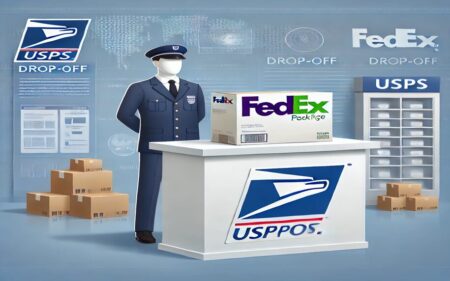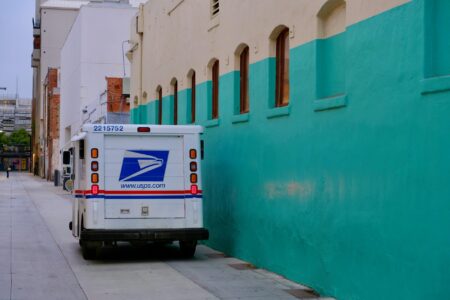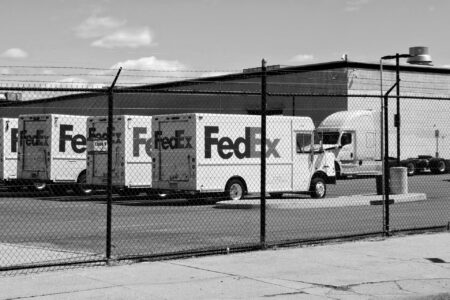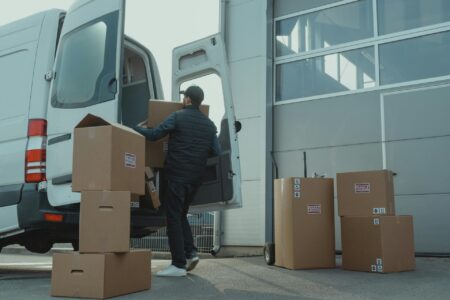Have you ever tracked a package and seen the status “Departed USPS Regional Facility”? If so, you’re not alone. Millions of packages travel through the United States Postal Service (USPS) network every day, and this status update is a common sight for many.
But what does it actually mean when your package “departs” a USPS regional facility? In simple terms, it’s good news – your package is on the move and getting closer to you.
This update is like a checkpoint in your package’s journey. It tells you that your item has left one of USPS’s big sorting centers and is on its way to the next stop. It’s a sign that things are progressing as they should. Keep reading to learn about it!
When you see “Departed USPS Regional Facility” in your tracking updates, it means your package has left one of the main USPS sorting centers and is on its way to the next destination in its journey, which could be another sorting facility or your local post office.
Key Takeaways
- USPS Regional Facilities are crucial hubs for sorting and redirecting mail to its next destination.
- Packages typically move from these centers to local post offices before home delivery.
- There are over 250 USPS regional facilities strategically located across the United States.
- Most packages don’t stay at a regional facility for more than 24 to 48 hours.
- After leaving a regional facility, packages are usually delivered within 1-5 days, depending on the distance and service type.
- Direct package pickup from regional centers isn’t common for the general public.
- Tracking services offer valuable insights into your mail’s progress through these facilities.
- During peak seasons like holidays, processing times at regional facilities may be slightly longer.
What Does “Departed USPS Regional Facility” Mean?
When you spot the “Departed USPS Regional Facility” status in your tracking information, it’s essentially telling you that your package has bid farewell to one of the USPS’s main sorting facilities. This update is a crucial checkpoint in your package’s journey, signifying that it’s moving through the postal system and getting closer to its final destination.
USPS regional facilities, also known as distribution centers or hubs, are the backbone of the postal service’s logistics network. These facilities act as central points where:
- Incoming mail and packages are sorted based on their destinations
- Items are redirected to other regional facilities or local post offices
- The flow of mail is managed efficiently across vast geographic areas
When a package departs from a regional facility, it means that it has been processed, sorted, and is now en route to its next stop. This could be another regional facility, a local post office, or in some cases, it might be heading straight for delivery.
As well as indicating progress, this status update helps you gauge the approximate location of your package. It’s worth noting that the time between this status and the next update can vary depending on factors like distance, service type, and current postal volume.
Understanding USPS Regional Facilities
USPS Regional Facilities are more than just waypoints in your package’s journey. They’re the nerve centers of the postal system, strategically located to optimize the movement of mail across the country. These facilities play a crucial role in the sorting and routing process, ensuring that millions of pieces of mail reach their intended destinations efficiently.
When your package departs from one of these facilities, it’s typically en route to another facility closer to its final destination or directly to the local post office for delivery. This system of regional facilities forms a complex network that allows the USPS to manage the enormous volume of mail it handles daily.
To put it in perspective, imagine these facilities as air traffic control centers for mail. Just as air traffic controllers guide planes to their destinations, these facilities guide your packages through the postal system, ensuring they take the most efficient route possible.
How Do USPS Regional Facilities Function?
USPS regional facilities are the unsung heroes of the mail delivery process. These bustling hubs operate round the clock, processing an immense volume of mail and packages daily. Here’s a glimpse into how these facilities keep your mail moving:
- Receiving: Trucks and planes deliver mail and packages from various origins.
- Sorting: Advanced machinery and skilled workers sort items based on destination zip codes.
- Processing: Packages are scanned, labeled, and prepared for their next journey.
- Dispatching: Sorted mail is loaded onto trucks or planes for the next leg of its trip.
These facilities use cutting-edge technology to ensure efficient sorting and processing. Automated sorting machines can handle thousands of pieces per hour, significantly speeding up the process. In addition to this, skilled postal workers oversee operations, handle special cases, and ensure everything runs smoothly.
Where Are USPS Regional Facilities Located?
The USPS has strategically placed its regional facilities across the United States to ensure efficient mail processing and delivery. These facilities are typically located in major cities or at important transportation hubs, allowing for quick distribution across different regions.
There are over 250 USPS processing and distribution centers nationwide. While not every state has its own regional facility, each state is serviced by at least one, ensuring that mail doesn’t have to travel too far before being sorted and redirected.
Some of the largest USPS regional facilities are located in:
- New York City, NY
- Los Angeles, CA
- Chicago, IL
- Miami, FL
- Dallas, TX
These locations are chosen based on population density, transportation infrastructure, and geographic positioning. By placing facilities in these strategic locations, the USPS can efficiently manage the flow of mail across the entire country.
For a complete list of USPS regional facilities, you can visit the USPS official website.
How Long Does It Usually Take for Mail to Move Between USPS Regional Facilities?
After your package departs from one regional facility, you might wonder how long it takes to reach the next one. The transit time between USPS regional facilities can vary, but typically it ranges from 12 to 48 hours. Several factors influence this timeline:
- Distance: Facilities that are closer together will have shorter transit times.
- Transportation Method: Air transport is generally faster than ground shipping.
- Mail Volume: During busy periods, transit times may increase slightly.
- Weather Conditions: Severe weather can occasionally cause delays.
It’s important to remember that this is just one leg of your package’s journey. The total delivery time depends on how many facilities your package needs to pass through before reaching its final destination.
What Happens After a Package Leaves a Regional Facility?
Once your package bids farewell to a regional facility, it embarks on the next leg of its journey. The next steps typically involve:
- Transit to Next Facility: Your package may head to another regional facility if it’s traveling a long distance.
- Local Post Office: For packages nearing their final destination, the next stop is usually the local post office.
- Out for Delivery: From the local post office, your package will be sorted onto delivery trucks.
- Final Delivery: The last step is delivery to your doorstep or mailbox.
The exact route your package takes depends on its destination and the current workload of various facilities. Rest assured, though, that at each step, your package is scanned and its tracking information updated, allowing you to follow its progress.
It’s important to note that after departing a regional facility, your package enters a crucial phase of sorting and routing. This is part of a logistical system designed to efficiently manage the flow of mail, often involving multiple stops along the way. Think of it as your package hopping from one lily pad to another, each hop bringing it closer to its final destination.
Why Does My Mail Keep Going Back and Forth Between the Same Regional Facility?
Sometimes, you might notice your package seemingly ping-ponging between the same facilities. While this can be frustrating, there are several reasons why this might happen:
- Sorting Errors: Occasionally, packages may be missorted and need to be rerouted.
- Address Issues: Incomplete or incorrect addresses can cause packages to be redirected multiple times.
- System Updates: Sometimes, what appears to be back-and-forth movement is actually just delayed scanning updates.
- Customs Clearance: For international packages, repeated scans at the same facility might indicate ongoing customs processing.
If you notice this happening, don’t panic. In most cases, these issues resolve themselves, and your package will find its way to you. However, if the back-and-forth continues for an extended period, it might be worth contacting USPS customer service for clarification.
How Soon Will Your Mail Be Delivered After Leaving a Regional Facility?
After your package waves goodbye to a regional facility, you’re probably eager to know when it will arrive at your doorstep. While delivery times can vary, you can typically expect your package within 24 to 72 hours after it departs a regional facility.
Several factors influence this timeline:
- Distance: Packages traveling within the same state often arrive faster than those crossing multiple states.
- Service Type: Priority mail generally arrives sooner than standard mail.
- Transportation Method: Air transport is typically faster than ground shipping.
- Local Post Office Workload: The volume of mail at your local post office can affect final delivery times.
To get a more accurate estimate, keep an eye on your tracking information. The USPS provides regular updates, allowing you to follow your package’s journey and anticipate its arrival.
It’s worth mentioning that in some cases, delivery may occur within a day or two, especially if the destination is nearby. However, for packages traveling longer distances, it may take additional time as they navigate through various facilities. As well as this, it’s not uncommon for packages to experience delays or lack of updates after departing a regional facility. This can be due to several factors, including high mail volume, weather conditions, or logistical challenges.
What Should I Do If My Mail Has Been Stuck at a Regional Facility for Days?
While it’s not uncommon for packages to spend some time at regional facilities, especially during busy periods, extended delays can be concerning. If your package has been stuck at a regional facility for several days, here are some steps you can take:
- Check for Service Alerts: Visit the USPS Service Alerts page to see if there are any known issues or delays in your area.
- Contact USPS Customer Service: They can provide more information and, if necessary, initiate an investigation.
- Submit a Missing Mail Search Request: If there’s been no movement for an unusually long time, you can file a missing mail search.
- Be Patient: Sometimes, packages may appear “stuck” due to a lack of scanning updates, even though they’re actually in transit.
Remember, the vast majority of packages do reach their destinations, even if they experience temporary delays along the way.
How Can I Track My Mail More Accurately to Avoid These Issues?
To get the most accurate and up-to-date information about your package’s journey, consider these tracking tips:
- Use the Official USPS Tracking Tool: The USPS Tracking page provides the most current information.
- Sign Up for Informed Delivery: This free service from USPS provides digital previews of your incoming mail and package tracking all in one place.
- Download the USPS Mobile App: Get real-time tracking updates on your smartphone.
- Enable Text or Email Alerts: Set up notifications to receive updates at key points in your package’s journey.
- Check Tracking at Different Times of Day: Scans often occur in batches, so checking at various times might yield new information.
By staying proactive with these tracking methods, you can keep a closer eye on your package’s progress and catch any potential issues early.
Are There Specific Times When USPS Regional Facilities Are Busier?
USPS regional facilities operate 24/7, but they do experience fluctuations in volume throughout the year. Understanding these busy periods can help you set realistic expectations for your package’s journey:
- Holiday Season: The period from Thanksgiving through New Year’s is typically the busiest time for USPS.
- Tax Season: Around mid-April, there’s often an increase in mail volume due to tax returns.
- Election Periods: During major elections, facilities see an uptick in mail-in ballots.
- Monday Mornings: After the weekend, Mondays tend to be busier as facilities process accumulated mail.
- After Major Sales Events: Following events like Black Friday or Cyber Monday, facilities see increased package volumes.
During these busy times, you might notice slightly longer processing times at regional facilities. Planning your shipments around these periods, when possible, can help avoid potential delays.
How USPS Regional Facilities Compare to Other Couriers?
USPS regional facilities differ from other major courier hubs in several ways:
- FedEx Hubs:
- Process up to 500,000 packages per hour at their SuperHub in Memphis.
- Focus on speed and efficiency for express deliveries.
- UPS Worldport:
- Sorts up to 416,000 packages hourly in Louisville.
- Specializes in air freight logistics.
- DHL Centers:
- Operate three main global hubs: Leipzig, Hong Kong, and Cincinnati.
- Prioritize international shipments.
USPS facilities offer unique advantages:
- Serve every US address, including remote areas.
- Provide more affordable options for standard mail.
- Handle official government mail and support services like mail-in voting.
Choose USPS for cost-effective domestic shipping and universal coverage. Opt for private couriers when speed is crucial, especially for international packages.
Understanding these differences helps you pick the right service for your shipping needs. Each carrier’s network suits different mailing requirements, so consider your priorities when deciding.
Frequently Asked Questions
How much does it cost to ship a package through USPS?
The cost of shipping a package through USPS can vary depending on the service, package size, and weight. As of 2023, the starting rates for USPS shipping are:
First-Class Package Service: $2.43 for packages up to 16 oz
Priority Mail: $8.75 for packages up to 1 lb
Priority Mail Express: $26.95 for overnight delivery
Q: Can I pick up my package from the USPS Regional Facility?
A: While it’s possible to pick up your package from a USPS Regional Facility, it’s not common practice. You would need to contact the facility in advance to schedule a pickup time. In most cases, it’s easier to wait for delivery or pick up from your local post office.
Q: Are USPS Regional Facilities always open?
A: USPS Regional centers typically operate during regular business hours. Some facilities may be open on weekends and holidays, but this can vary by location.
Q: How often are packages scanned at USPS Regional Facilities?
A: Packages are usually scanned upon arrival and departure at regional facilities. However, during busy periods, some scans might be missed or delayed.
Conclusion
The “Departed USPS Regional Facility” tracking update is a standard alert that indicates your package is moving as it should, having left one sorting facility and continuing its journey toward the delivery destination.
Remember, if you have any concerns or questions, don’t hesitate to reach out to USPS or your local post office for assistance. They’ll be more than happy to provide you with the information you need to stay informed and get your package delivered safely and on time.











Leave a Reply